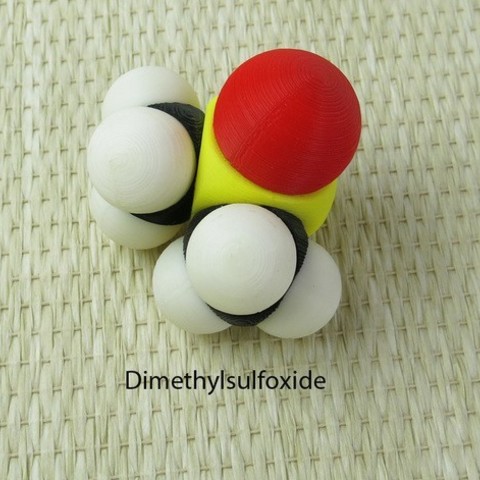
Space-filling molecular models: Sulfur and Phosphorous expansion pack
cults3d
This expansion set lets you create sulfur and phosphorus containing compounds, which together with the other expansion sets will provide you with almost everything you need to produce most biological molecules. Sulfur is situated just below oxygen in the periodic table, and like oxygen it generally forms a single bond with two other atoms at an angle. This angle is typically around 96 degrees, but it can be many others. The sulfur you will need for most biological compounds is Sulfur96; I've shown ethanethiol as an example, which is the chemical they use in natural gas to detect leaks. Sulfur can also have up to two oxygens double bonded to it. The most common example of this is sulfate (Sulfur2), which I've represented as sulfuric acid. Sulfur can also have just two double bonded oxygens, forming sulfur dioxide (Sulfur120). In this molecule the oxygens form a 120 degree angle; many other sites will gladly explain why this occurs, so I won't bother. You can also have just one extra oxygen bonded. The only example of this that comes to mind is dimethylsulfoxide, or DMSO. "Okay, what is DMSO," you might ask. DMSO is an extremely useful solvent which can be used to dissolve most medications; in fact it works so well that many researchers use it when another solvent (such as water) would be better suited (if I sound like a pharmacologist with some issues with DMSO, you'd be correct). DMSO readily penetrates the skin and anything dissolved in it (like a drug). While this sounds like a useful way to avoid injections, DMSO tends to give you very bad breath so it's not used much. By the way, since this is the only molecule of its type I can think of, I've set up the sulfur so that it will produce DMSO exactly (SulfurDMa; the oxygen goes into the socket isolated from the other two). So if you really want to make DMSO, you know how to do it. Sulfur also forms some aromatic compounds, typically having five-membered rings (the example I show is thiophene). I'm afraid I cheated a bit here; sulfur is actually quite large and distorts the other atoms in the ring (not uniformly either); because I didn't want to remake all the other atoms, I just distorted the sulfur (SulfurPh5b). This gives you an idea of how much space sulfur takes up, which is really the purpose of space-filling models anyway. If someone's thesis depends on this being accurate, we can discuss it further. As another example of sulfur compounds, I've included sulfathiazole, which has two sulfurs in different chemical environments. Sulfathiazole is an antibacterial agent that isn't used much anymore, but which has a surprising number of references in popular literature (check Wikipedia). Sulfur is actually capable of many more valence states than I've shown here, so you're getting off easy. Phosphorus is almost exactly the same size as sulfur; the bond lengths are just a bit shorter though. I probably could have just printed sulfur in a different color and called it phosphorus, but I stand by quality. Speaking of color, while the color of phosphorus isn't as standardized as it is for other atoms, it's usually not shocking pink (this just happened to be the color I had available). Phosphorus is also capable of a large number of valence states, but for biological molecules, it mostly forms bonds with oxygen and sulfur. The most common example of this is pyrophosphate (PPi), which is used in many biochemical reactions. The expansion pack includes several oxygens that can be used to bond phosphates together at different angles. One of them (Oxygen3S) I just modified slightly so it looked better bonded with sulfur; it printed better too. However, when I tried to use it to make pyrophosphate, the phosphates wouldn't go together properly. So I looked it up and found that the dihedral angle for oxygen binding two phosphates is between 126 and 129 degrees (OxygenPP2). When I made that, they went together perfectly. I had a similar problem when I tried to attach the triphosphate group to the ribose of ATP; again, when I looked it up, it turned out that the angle is 117 degrees (Oxygen117). The fun thing about 3D printing is that when you need a different oxygen, you can just make it.
With this file you will be able to print Space-filling molecular models: Sulfur and Phosphorous expansion pack with your 3D printer. Click on the button and save the file on your computer to work, edit or customize your design. You can also find more 3D designs for printers on Space-filling molecular models: Sulfur and Phosphorous expansion pack.
